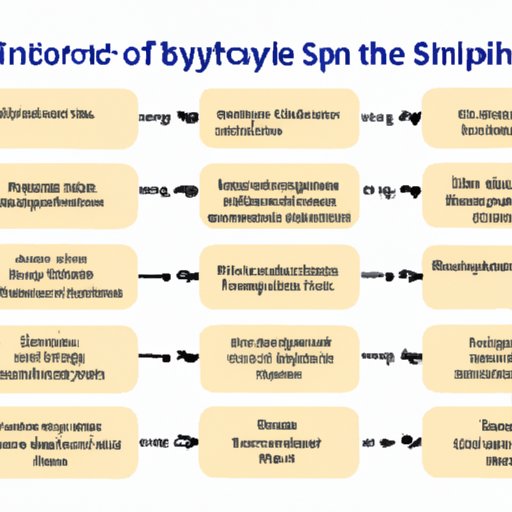Introduction
Syntax is the structure of a written language that defines how words and phrases are arranged to create meaningful sentences. It is an essential element of language, without which it would be impossible to convey ideas or communicate effectively. In this article, we will explore the role of syntax in literature and discuss how it can be used to improve reading comprehension and literary analysis.
What is Syntax and How Does it Impact Literature?
Syntax is the ordering of words, phrases and clauses in a sentence to convey meaning. It is the foundation of all written language, as it enables the writer to express their thoughts and ideas in a clear and concise manner. In literature, syntax is used to create interesting and creative effects that add depth and texture to the text. By manipulating the order of words and phrases, writers can evoke certain emotions or convey a specific message to the reader.
There are several types of syntax used in literature, including parallelism, chiasmus and antithesis. Parallelism is the use of similar or repeated phrasing or structures to make a point. Chiasmus is the reversal of the order of words or phrases in successive clauses to create a poetic effect. Antithesis is the juxtaposition of contrasting words or ideas to emphasize a point. All of these techniques can be used to enhance the tone, style and overall impact of a piece of writing.
In addition to creating stylistic effects, syntax also plays an important role in understanding the meaning of a text. When a reader encounters a sentence with incorrect syntax, they may struggle to comprehend the intended meaning. This is why it is important for writers to pay attention to the structure of their sentences when crafting a piece of writing. A well-crafted sentence with correct syntax can make it easier for readers to understand the message being conveyed.

Exploring the Role of Syntax in Literary Works
Writers often use syntax to create interesting effects in their works. For example, in Shakespeare’s play “Romeo and Juliet,” he uses parallelism to emphasize the tragedy of the lovers’ death: “For never was a story of more woe, than this of Juliet and her Romeo.” The repetition of the phrase “this of Juliet and her Romeo” emphasizes the tragedy of the situation and creates an emotional impact on the reader.
In poetry, syntax is used to create rhythm and flow. Poets often use techniques such as enjambment and caesura to create a musical effect in their works. Enjambment is the continuation of a sentence or phrase over multiple lines of verse, while caesura is the breaking of a line into two or more parts for emphasis. These techniques can help create a sense of rhythm and movement in a poem, which enhances the overall experience for the reader.
Syntax is also used to express complex ideas in a concise manner. Writers often use techniques such as ellipsis and inversion to convey a lot of information in a few words. Ellipsis is the omission of words or phrases from a sentence to create a more compact statement. Inversion is the rearrangement of the normal word order in a sentence to create emphasis or change the meaning. These techniques can help writers express complex ideas in a succinct way, which makes them easier to comprehend.
A Guide to Understanding Syntax in Writing
Understanding syntax is essential for anyone who wants to write effectively. To identify syntax in a piece of writing, look for patterns in the way words and phrases are arranged. Pay attention to the order of words, the placement of punctuation marks, and the use of repetition or contrast. These elements can help you determine the type of syntax used in a sentence and the overall effect it has on the text.
When studying syntax, it is also important to consider the context of the sentence. Consider how the syntax of the sentence contributes to the overall meaning of the text. Analyzing the syntax of a sentence can help you gain a better understanding of the author’s intent and the significance of the text.
To improve your understanding of syntax, read a variety of texts and pay attention to the structure of sentences. Familiarize yourself with different types of syntax and practice identifying them in written texts. You can also consult resources such as grammar books or online tutorials to learn more about syntax and how it affects writing.
The Significance of Syntax in Poetry and Prose
Syntax plays an important role in both poetry and prose. In poetry, syntax is used to create rhythm and flow, which helps to create an emotional impact on the reader. In prose, syntax is used to express complex ideas in a concise and clear manner, which makes the text easier to comprehend.
In poetry, syntax is used to create a musical effect by manipulating the order of words and phrases. Poets often use techniques such as enjambment and caesura to create a sense of rhythm and movement. In prose, syntax is used to convey complex ideas in a concise and clear manner. Writers often use techniques such as ellipsis and inversion to express a lot of information in a few words.

Analyzing Syntax for Improved Reading Comprehension
Analyzing syntax can help you gain a better understanding of a text and improve your reading comprehension. When you analyze syntax, you can identify patterns in the arrangement of words and phrases, which can help you determine the author’s intent and the overall meaning of the text. You can also identify stylistic devices used by the author and gain insight into the structure of the text.
To analyze syntax, look for patterns in the arrangement of words and phrases. Pay attention to the order of words, the placement of punctuation marks, and the use of repetition or contrast. Also consider the context of the sentence and how the syntax contributes to the overall meaning of the text. By analyzing the syntax of a text, you can gain a deeper understanding of the author’s intent and the significance of the work.

A Comprehensive Overview of Syntax in Literature
Syntax is an essential element of language and plays an important role in literature. It is used to create interesting and creative effects that add depth and texture to the text. Writers often use syntax to express complex ideas in a concise manner, which makes the text easier to comprehend. Syntax is also used to create rhythm and flow in poetry, which helps to create an emotional impact on the reader.
By analyzing the syntax of a text, readers can gain a better understanding of the author’s intent and the overall meaning of the text. It is important for writers to pay attention to the structure of their sentences when crafting a piece of writing, as incorrect syntax can make it difficult for readers to comprehend the intended message. A well-crafted sentence with correct syntax can make it easier for readers to understand the message being conveyed.
Conclusion
Syntax is an essential element of language and plays an important role in literature. It is used to create interesting and creative effects that add depth and texture to the text. Writers often use syntax to express complex ideas in a concise manner, which makes the text easier to comprehend. By analyzing the syntax of a text, readers can gain a better understanding of the author’s intent and the overall meaning of the text.
Understanding syntax is essential for anyone who wants to write effectively. To identify syntax in a piece of writing, look for patterns in the way words and phrases are arranged. Pay attention to the order of words, the placement of punctuation marks, and the use of repetition or contrast. By doing so, you can gain a better understanding of the author’s intent and the significance of the text.
Syntax is an important element of language and plays a significant role in literature. It is used to create interesting and creative effects that add depth and texture to the text. By understanding syntax and analyzing it in written texts, readers can gain a better understanding of the author’s intent and the overall meaning of the text.
(Note: Is this article not meeting your expectations? Do you have knowledge or insights to share? Unlock new opportunities and expand your reach by joining our authors team. Click Registration to join us and share your expertise with our readers.)
